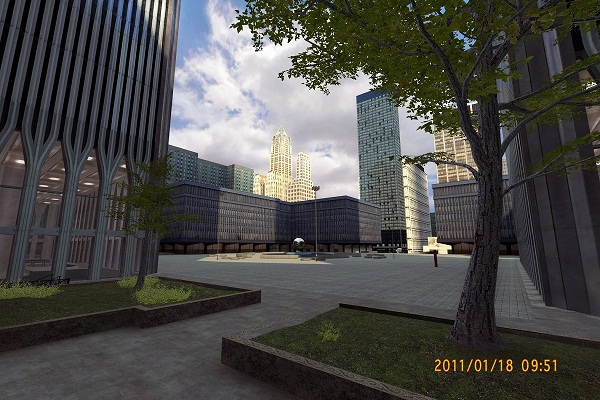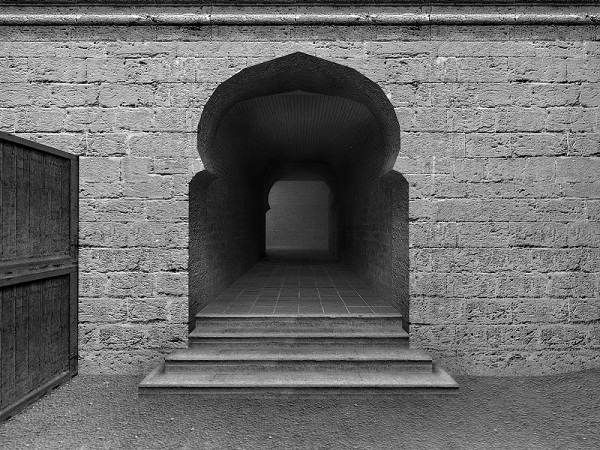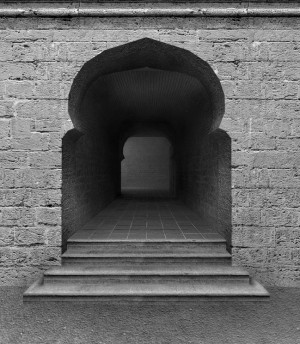Artist of the Week 09/05 – 09/11: Oliver Warden Conveys an Analogous Reality through Otherworldly Video Game Art
From out of his studio apartment, located on a mysteriously unmarked street in Bushwick, New York, Oliver Warden displays selected works on his gessoed white walls, an attempt at replicating the walls of a gallery. Walking through the domestic exhibit, most of his pieces are oversized, nearly meeting the floor with the ceiling, which is why I immediately take notice to the only exception in the room. I begin to walk over to the opposite wall from where I’m standing. Three 4’’ x 6’’ glossy prints are pinned side-by-side, two of which are of nondescript city high rises, while the third is unmistakable. I’m looking at The Twin Towers, but it is dated January 23rd, 2011 — months after the tragic event.
Since 2002, Warden has been creating so-called, video game photography under the pseudonym ROBOTBIGFOOT. The name is a reference to an episode of the 1970s television show, The Six Million Dollar Man, in which Steve Austin encounters Big Foot, rips his arms off, and finds out its actually a robot. While the name is obscure — Warden only knows of two people who’ve ever understood the reference — and may seem silly, it’s proven to be an apt metaphor for the deception that characterizes Warden’s work. Unabashedly, he describes how tension is intended to inform his work as a projection of his fourth generation Japanese-American identity, which toes the line between “both sides of the bomb.” Originally from Cleveland, Ohio, Warden spent a youthful two-year stint in Los Angeles before moving to New York at the age of 20.
While many may be tempted to roll their eyes at the idea of art derived from video games, Warden is an unapologetic philosopher whose artwork is a creative visual extension of rumination and introspection. Reflecting on how his time is divided between virtual and actual reality, Warden says, “The thing I’m starting to suspect is that fantasy is less of an alternative to reality and more of a lifestyle choice, like choosing to be healthy or educated.” When asked what he means by that, Warden proceeds to tell me about going to Disneyland as a child, “we walked into some restaurant with animal heads mounted on the wall, and then all of the sudden, they started singing. Even in this dumpy restaurant, it never breaks face; it never ceases. World of Warcraft, SecondLife, even Facebook, all function the same way. We choose to enter into these worlds, fully immersing ourselves, and we never have to leave the fantasy; we can build it out. We create our identity online, and manage it virtually through software.”
Likening himself and his artistic peers to superheroes, Warden elaborates on the struggle to be understood by the general public. “I think of the story of Superman that was created by an artist and a writer in Cleveland where I’m from,” he says. “This guy has superpowers that alienate him from Smallville. He comes to the metropolis, finds The League of Justice — his peer group who’ve also felt alienated — and they exercise their powers while forming alter egos. This is not unlike the story of artists who also feel alienated by their own Smallvilles, move to the city, find a community of others just like them, and go on to invent who they are. The superpower isn’t flying or invisibility; few people can understand the power of the artist. Our power is talent.”
Warden’s work was featured at Danziger Gallery in New York City in 2010, as James Danzinger’s first video game artist. It was a personal breakthrough, but more importantly, as Warden says, “it helped bring video game art into the realm of virtual photography, or as James referred to it as: “’camera-less photography.’”
GALO: How did you realize the artistic potential of video games as fine art photography?
Oliver Warden: I started making video game photography inside Tribes (Sierra, 1998), a massive multi-player online first person shooter (MMOFPS) video game. It was a beautiful game, rich with fluid gameplay and excellent graphics for its time. I was invited into a tribe, and it was the first time in my life that I’d ever been asked to join a group of any kind. You’re the size of an ant in a fortress, and when everyone showed up to greet me, they asked if I wanted to climb the wall as a kind of initiation. I looked up, and [saw] that it stretched for miles up to the sky above. It took four hours to reach the top, and when I looked down below, I had a moment. The wall was part of the fortress, and from atop this virtual summit, I saw a world of icicles floating below, but more significantly, in that moment I realized I could ignore the objective of the game and what I could do was make art.

A city view done by artist Oliver Warden. Photo Courtesy of: Oliver Warden.
GALO: Do you ever get mixed up between Oliver Warden and ROBOTBIGFOOT? How do you distinguish between the two?
OW: I had a friend over some time ago, and as we were looking at one of my images, I told him, “I’ve been down that hallway a thousand times.” Immediately, he responded, “No, you haven’t.” He revealed the fact that my mind was in the Matrix, so to speak. My memories of the past are a mix of trips I’ve taken and places I’ve never physically been [to]. It’s a little confusing. The emotions are there, but I have to remind myself what’s real and how it’s real.

“Rush B Tunnel” by artist Oliver Warden. Photo Courtesy of: Oliver Warden.
GALO: Fundamentally, your art is rooted in two elements: art and video games. What is your artistic background, and what is the basis of your relationship to video games?
OW: I was pulled out of class in first grade for a drawing I made, and was taken to the principal’s office. I drew a leprechaun dancing in a room but I had drawn the room in full one-point perspective. I guess this was unusual, because he called my parents that day and told them to enroll me in art classes. I started at the Cleveland Museum’s Saturday classes and practically grew up there. From there, I went to the Cleveland Institute of Art’s special classes, Baldwin Wallace’s college courses and ended up in night classes drawing nudes, all before graduating from high school. After that, I went to Otis Parsons Art Institute in LA, then a midway transfer to The School of Visual Arts in NYC for my BFA, and NYU’s Interactive Telecommunications Program (ITP) for my masters — somewhere, in all that, was a lot of LEGOs, drawing, movies and video games.
I’ve enjoyed playing video games since childhood. I used to play ping pong in my grandma’s basement every week. One day, I came over, and she asked if I wanted to play in the living room. It made no sense. I went in and there was an Atari 2600 with Pong on the screen. From that point on, it was over, as in “game over.” I wrote my first “choose your adventure” game on Radio Shack’s TSR80 when I was a teen and have kept playing for over 30 years. Nowadays, if you hear someone screaming at you in Left4Dead 2, it’s probably me, playing as my avatar for the last 12 years, ROBOTBIGFOOT.
(Article continued on next page)

